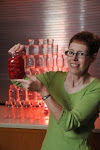Squash: Good Looking and Good Tasting
What reminds us more of autumn than colorful squash? The brilliant colors and unique shapes and marking make squash decorative as well as delicious and nutritious. Squash is plentiful in Wisconsin and usually a good buy.
Winter squash is most commonly available in the fall. Winter squash has a harder shell and a higher sugar content than summer squash. The center cavity contains large, hard seeds that are sometimes roasted, salted and eaten as a snack like nuts.
Varieties of winter squash include:
 |
| Acorn Squash |
 |
| Butternut Squash |
 |
| Buttercup Squash |
 |
| Delicious Squash |
 |
| Hubbard Squash |
Winter squash is higher in calories than summer squash, but also higher in vitamins A, C, and niacin. A ½ cup serving provides about 65 calories.
When selecting winter squash, a hard, tough rind indicates full maturity. Select squash that is heavy for it’s size. Slight variation in skin color does not influence flavor. Avoid squash with cuts, punctures, sunken or moldy spots on the rind as these indicate decay. A tender rind is a sign of immaturity and means poor eating quality in winter squash.
One pound of winter squash yields about one cup of mashed cooked squash.
Hard-shelled squashes have a sweet, nutty flavor. They are delicious when broiled, baked, or mashed and served with butter, cinnamon, nutmeg or brown sugar. Acorn squash halves are perfect for stuffing halves with mixture of diced apples, fresh lemon juice, butter and spices. Winter squash can be sliced into rings and cooked in butter, or scalloped.
Source: Squash Good Looking and Good Eating, UW-Extension Publication





No comments:
Post a Comment